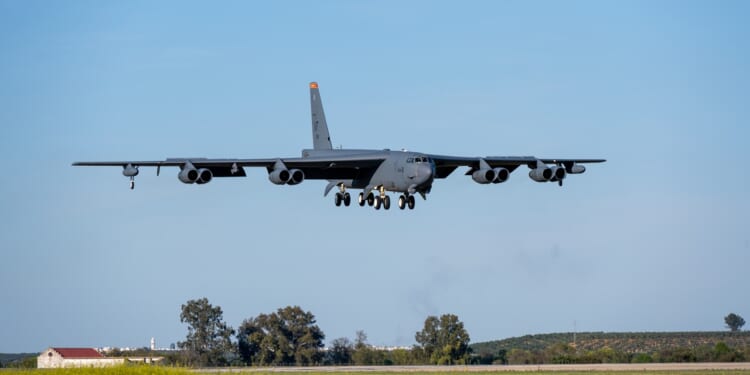Bomber Task Force missions are never announced in advance and vary in terms of time and location, intended to keep US adversaries unprepared.
Even as the longest government shutdown in United States history appears to be on the verge of ending, there will continue to be disruptions to air travel throughout the country. However, the United States Air Force was able to carry out its latest Bomber Task Force (BTF) mission without incident. On Saturday, US Air Forces in Europe – Air Forces Africa (USAFE-AFAFRICA) announced that Boeing B-52 Stratofortress long-range strategic bombers from Barksdale Air Force Base (AFB), Louisiana, arrived at Morón Air Base, Spain, as part of BTF Europe 26-1—the first such mission for fiscal year 2026 (FY26).
The three bombers, which flight trackers identified with the call signs CAGER 11, CAGER 12, and CAGER 13, were supported by US-based KC-46 Pegasus and KC-135 Stratotanker refueling aircraft during the flight to Europe.
BTF Europe 26-1 is the first deployment of B-52 bombers to Spain since May, but the aircraft will operate beyond the Iberian Peninsula. The USAFE-AFAFRICA also announced that the bombers will “conduct multilateral training operations alongside Finland, Lithuania, and Sweden, as well as other Allies and partners.” As with previous BTF missions, the deployment is also meant to help familiarize US Air Force bomber aircrews with operations across Europe, and to refine tactics, and “strengthen coordination with Allies.”
It is unclear how long the planes will remain in Spain, but the previous BTF deployment to Morón Air Base lasted just over a week. US Air Force BTF missions are designed to be as unpredictable as possible, with deployments typically not announced in advance—so as to give as little warning as possible to regional adversaries like Russia.
“By strategically deploying forces and assets through multilateral training like this, the US Air Force is better postured to respond rapidly to emerging threats and maintain a credible deterrent along Europe’s Eastern Flank and the High North,” explained USAFE-AFAFRICA.
The B-52 Stratofortress’ Specifications
- Year Introduced: 1955 (B-52 entered USAF service in February 1955)
- Number Built: 744 (all variants); ~76 B-52H airframes still in service
- Length: 159 ft 4 in (48.5 m)
- Wingspan: 185 ft 0 in (56.4 m)
- Weight (MTOW): ~488,000 lb (221,000 kg)
- Engines: Eight Pratt & Whitney TF33-P-3/103 turbofan engines (~17,000 lbf / ~76 kN thrust each); planned/announced re-engining programs (e.g., Rolls-Royce F130/BR700 family derivatives) for future service life extension
- Top Speed: ~650 mph (1,046 km/h); about Mach 0.86 at altitude (approx.)
- Combat Radius: Mission- and load-dependent; typical practical combat radii vary widely (roughly several thousand miles / ~3,000–7,000 km depending on payload, routing, and aerial refueling)
- Service Ceiling: ~50,000 ft (15,240 m); varies depending on loadout
- Loadout: ~70,000 lb (≈31,500 kg) of mixed ordnance
- Aircrew: 5 (pilot, co-pilot, weapon systems officer, navigator, electronic warfare officer); varies based on loadout / mission parameters
The first B-52s entered service in June 1955, and by the time production of the Stratofortress ended in 1962, a total of 744 had been built. Currently, there are 58 B-52 bombers in active service, with another 18 in reserve and another dozen or so in long-term storage.
The bombers have flown under various commands during their 67 years of service—mostly with the Strategic Air Command (SAC), until it was disestablished at the end of the Cold War in 1992 and its aircraft were absorbed into the Air Combat Command (ACC). Since 2010, all B-52 Stratofortresses have flown under the Air Force Global Strike Command (AFGSC).
The remaining B-52s have undergone significant updates and will receive further upgrades, including new engines, to keep the long-range, subsonic strategic bombers in service at least into the 2050s. The B-52 has no scheduled expiration date—meaning the aircraft are expected to reach 100 years of service, and possibly well beyond.
More B-52s Have Been Flying Over the Caribbean
The deployment of three B-52s to Europe follows a patrol flight of two of the Cold War Stratofortress bombers along the coast of Venezuela last Thursday. This latest “Bomber Diplomacy” mission was the fourth show of force involving US Air Force bombers in recent weeks, as part of the Pentagon’s undeclared war against alleged drug smugglers. The first such sortie involved three B-52s from Barksdale AFB in mid-October.
The US bomber flights in the Caribbean may be calculated to send a clear message to Venezuela, as the Trump administration maintains that the regime of President Nicolas Maduro has close ties to the Cártel de los Soles cartel, and early this year placed a $50 million bounty on the South American strongman.
Beyond its offensive capabilities, the B-52 can also be outfitted with sensors and targeting pods that can spot and track suspected drug smuggling vessels and aircraft, with information relayed to other US forces in the region.
About the Author: Peter Suciu
Peter Suciu has contributed over 3,200 published pieces to more than four dozen magazines and websites over a 30-year career in journalism. He regularly writes about military hardware, firearms history, cybersecurity, politics, and international affairs. Peter is also a contributing writer for Forbes and Clearance Jobs. He is based in Michigan. You can follow him on Twitter: @PeterSuciu. You can email the author: [email protected].
Image: Shutterstock / Joseph Creamer.
















